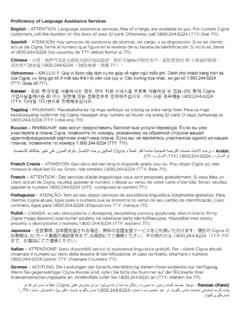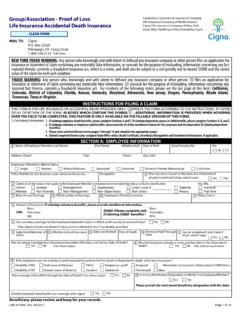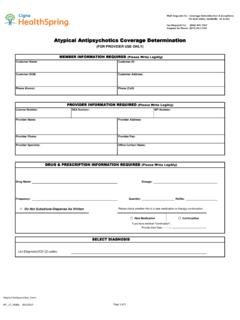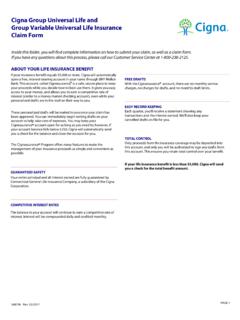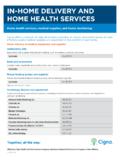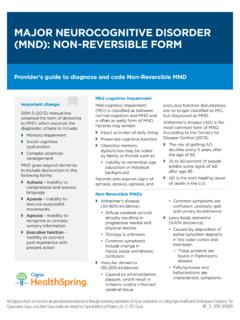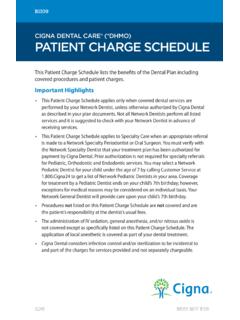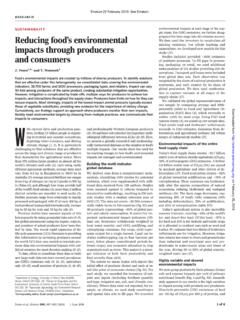Transcription of HOW TO COMPLETE A 360 COMPREHENSIVE EXAM
1 Page 1360 Identifying Information to be completed in its entirety Patient s first and last name Date of birth Date of service Patient ID Rendering health care professional (provider that completes the 360) Patient s PCP name and NPI Location 360 was completed and source of collected informationPlease note: Each page of the 360 COMPREHENSIVE Exam must include the patient s name, date of birth and date of for exam must be documented Acceptable reasons include phrases such as: COMPREHENSIVE Exam 360 Past medical history (PMH) It is not necessary to document every condition the patient no longer has; please keep diagnoses pertinent to those that would best demonstrate the patient s health status, and/or those conditions that require medical follow-up or attention If there is no pertinent PMH please choose box Reviewed and no past medical history All Cigna products and services are provided exclusively by or through operating subsidiaries of Cigna Corporation.
2 The Cigna name, logos, and other Cigna marks are owned by Cigna Intellectual Property, Inc. 2018 Cigna INT_18_63116 01192018 HOW TO COMPLETE A 360 COMPREHENSIVE EXAMA page by page guide for 2018 OverviewThe 360 COMPREHENSIVE Exam must be completed during a single face-to-face encounter and completed by an acceptable health care professional (MD, DO, PA, NP). The only attachments allowed are the medication list and depression screening supplements (PHQ 9, standard screening tool and/or clinical interview) Clinicians should not refer to other documents in the medical record, such as see the HMR , or refer to the progress note in order to COMPLETE any section of the 360 COMPREHENSIVE only elements that may be pulled from a prior date of service would be as follows: Surgical history Family history Lab results within the past 180 days are preferable, however the most recent lab results within the last year are acceptable.
3 Diagnostic and/or preventive screenings, such as mammography, colorectal, or bone density, (based on CMS quality measure and frequency range as indicated within 360 exam)In preparation to COMPLETE the COMPREHENSIVE Exam, you will need the following information: Patient chart/medical records Stars/HEDIS/Preventive - measures due information (as noted by asterisks on the paper form) The 2018 - 360 COMPREHENSIVE Exam formPage 1 Surgical history Please make note of the patient s surgical history, along with known date If room is a factor, it is only necessary to document pertinent surgeries; examples would include CABG, PTCA, acquired absence of organ, pacemaker status, AAA repair, and/or ostomy status, etc.
4 Transplant status is a section designed to document if the patient has had a transplanted organMedications Please list all of the medications the patient is currently taking, including OTC s, with dosage and frequency If corresponding box is checked, you may attach a printed medication list or neatly printed list and this must be signed with provider s name, credentials and date (same as DOS) Allergies Please document all known allergies and reaction or check box No known drug allergies Seasonal allergies do not apply hereFamily history COMPLETE this area as thoroughly as possible or document Reviewed and no relevant history if accurate If the family history is unknown or the section is left blank you must add statement of why (ex.)
5 Adopted or dementia)Habits and social history Please COMPLETE thoroughly including memory, vision, hearing, speech, illicit drug use, tobacco use, and alcohol usePage 2 Fall risk screening Must be completed on all patients receiving the 360 exam Mark all that apply to the patient and add the total number of boxes checked at the bottom If the patient has none of the applicable risk factors please mark 0 as the total to assure we ve noted it as addressedMost common questions regarding fall risk screening Diagnoses (3 or more existing) this would be 3 or more chronic, comorbid diagnoses (ex: DM, CHF & CKD) Environmental hazard this is up to the health care professional s discretion Polypharmacy defined as patients currently taking 4 or more medications When applicable check box for: Unable to perform exam b/c of Check box for: Fall risk (4 or more reported)Depression screening Must be completed on all patients receiving the 360 exam If two or more yes boxes are checked please COMPLETE and attach either the PHQ 9 form, standard screening tool and/or clinical interview When applicable check box for.
6 Screening not performed because the patient is unable to communicate/answerUrinary incontinence screening Must be completed on all patients receiving the 360 exam Review of systems Check (EACH) negative box or document positive findings EACH system must be addressed (ROS: General, HEENT, Cardiac, Respiratory, GI, Musculoskeletal, Neurological, Skin, Psychiatric, Endocrine, Hematological, GU) Positive findings should include signs and symptoms If left blank, the 360 exam will have to be repeated during a new face-to-face date of servicePain screening Must be completed on all patients receiving 360 exam Rate the overall pain presence in the patient s day-to-day life along with plan If the patient has no chronic pain, please mark 0 and document the plan as being N/A to assure we ve noted it as addressed When applicable indicate reason if pain screen can t be completed (ex.)
7 Dementia)Foot exam Must be completed on all members that are diagnosed with diabetes, but may also be completed on patients with suspect conditions which would require a thorough foot exam At least 3 of the first 4 components must be addressed to reflect a completed diabetic foot exam In Box 5, please document any complications from the foot exam The diagnoses marked in box 5 MUST correspond with current conditions section If there is a clinical reason why the foot exam is left blank, this reason must be documented (ex: amputation)Page 3 Vitals All vitals must be documented; including a calculated BMI and patient gender If there is a clinical reason why any of the vitals are left blank, the reason must be documented (ex: bedbound) COMPREHENSIVE exam Must be completed by examining health care professional Check (EACH) normal box or document abnormal findings EACH system must be addressed (PE.
8 General, HEENT, neck, heart, lungs, breast, abdomen, extremities, GU, musculoskeletal, neurological, skin, psychiatric, lymphatic, hematologic) The breast, GU, and hematological exams may be addressed as deferred - Abnormal findings should include physical findings Findings for medical and surgical history, ROS and diagnoses should be supported by the COMPREHENSIVE exam if applicable If left blank, the 360 exam will have to be repeated during a new face-to-face date of serviceCurrent Conditions Pages 3 through 6 Go through each diagnosis section and check current diagnoses and mark corresponding treatment and management plans Treatment and management plans MUST be documented for EACH diagnosis selected If the patient does not have a condition in a specific section, then document.
9 Reviewed and no active disease if applicable There are Other diagnosis spaces at the bottom of each section that allows for a diagnosis that is not listed to be documented Be sure to identify additional selections for further specificity; some of the main diagnoses have additional options for specificityPay special attention: Cardiovascular When documenting history of and/or MI diagnosis the date of MI must be noted Specify the type of MI: - Type 1 = NSTEMI and STEMI - Type 2 =Demand ischemia etiology - Type 4 = Percutaneous procedural etiology, coronary angioplasty and/or stenting - Type 5 = Cardiac surgery etiology, CABG Document specific type of heart failure as either left, right, diastolic, systolic, or combined systolic & diastolic Specify the type of pulmonary hypertension based on etiology.
10 - Type 2 = left heart [mitral valve disease] - Type 3 = lung disease [COPD] - Type 4 = embolic [pulmonary embolus] - Type 5 = multi-factorial [sarcoid & vasculitis] When documenting hypertension indicate type and date of diagnosis, if known Consider linking primary diagnoses, hypertension to secondary co-morbid manifestations, chronic kidney disease Nutritional/Metabolic/Endocrine Document if the patient has malnutrition, obesity, and/or thyroid disorders Consider documenting a co-morbid manifestation, hypertension or diabetes mellitus, when the patient has a BMI between and Diabetes mellitus Document the type of diabetic mellitus and also document all complications/manifestations When chronic kidney disease (CKD)
